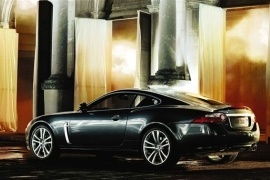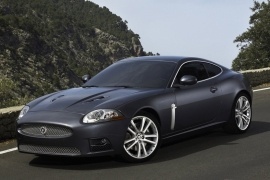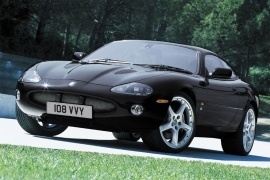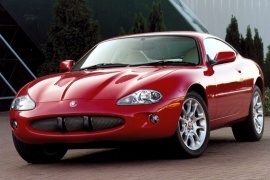
JAGUAR XKR
Generations Timeline, Specs and Pictures

Designed to change the character of the XKR without completely throwing it away, the XKR-S came with an explosive performance given by the updated engine.
More expensive than the standard XKR, the XKR-s featured a redesigned exterior look with a new front fascia, bigger wheel and a spoiler at the back - all to increase stability at high speeds. And the XKR could go up to 300 km/h.
The most important changes were to be found underneath, as Jaguar improved the XKR in almost every aspect: the front suspension was stiffened, resulting in a better steering and handling precision. The electronic differential software and the damper control software were updates, as well as the steering system software.
While the XKR-S featured all of qualities of the regular XKR, it offered an extra level of precision, more power and more torque. The upgraded 5.0-liter supercharged engine produced 550 hp and 502 lb.-ft of torque.
The exhaust system was refreshed to provide a more exciting sound.
Inside, the XKR-s came with specific carbon-leather trimmed versions of the Jaguar’s Performance seats. The heated seats were fitted with integrated head rests and racing harness cut-outs. The 16-way adjustable seats had carbon leather inserts with contrast micro piping. Soft touch classy materials were used throughout the cabin, giving a feeling of exclusivity.

Released from Ford’s dominance, Jaguar found a new way to improve its cars and offered a heavily revised XKR in 2009.
Jaguar was back! The British brand brought a facelifted version of the XKR at the 2009 North American International Auto Show in both forms as a convertible and coupe. The new management decided to invest more in the engineering department, and the new GT was not only sportier but also looked better.
The coupe showed a new set of headlights and a new bumper that included a mesh-grille in the lower apron from the outside. The elliptic grille placed in front of the radiator resembled the one installed on the legendary E-Type. Jaguar’s design team kept the hoods vents as a statement for the performance version, and in the rear, it added a trunk-spoiler. To complete the sporty image, the team insisted on keeping the four-exhaust system.
Inside, the carmaker installed the gear selector’s rotary silver wheel carried over from its four-door sibling, the XF. Inside the instrument cluster, a TFT display stood between the tachometer and speedometer. Depending on the options, the XKR featured either wood or aluminum trims on the door panels and the center stack.
Under the hood, Jaguar installed a completely new 5.0-liter V8 supercharged engine. It offered 23% more power and 12 percent more torque than its predecessor. It was paired as standard to a 6-speed automatic gearbox with paddle-shifters behind the steering wheel.

The XKR-S was the ultimate Jaguar of those times.
It wasn’t much powerful than its XKR sibling, but it wasn’t the same luxury grand tourer car.
Ford announced in 2007 that it would sell Jaguar, a dealt that happened in 2008 to the Tata Group, an Indian consortium. That was a hard time for the struggled British carmaker, and the XKR-S appeared in a moment when nobody could say what will be the future of that glorious brand. Fortunately, things got straightened up, and Tata took good care of the brand. But before any papers were signed, Jaguar’s engineers developed a faster version of the XKR: the XKR-S.
From the outside, there were just a few details that would tell the difference. First, it was the color. The S version was available only in black color. At the front, a new mesh-grille was installed in the lower bumper area and on the sides, in the fog-lights clusters. A lip-spoiler enhanced the look and the aerodynamic of the car. Like its non-S version, it featured silver vents behind the front fenders.
In the rear, there were only a few details that differentiated the S version. There was a specific splitter under the bumper, with chromed quad exhausts.
Inside, the car featured a similar interior to the XKR version, with high-bolstered seats and standard automatic transmission with paddle shifters behind the steering wheel.
The real difference was under the body, where the engineering team increased the power of the 4.2-liter supercharged engine. Another significant improvement was for the suspension, which was stiffer than on the regular XKR. Unfortunately, they didn’t consider installing an LSD, and that affected the car’s handling on the track.

An old powerful heart, but a brand new exterior design that transformed the XKR into a real head turner.
While the drivetrain was nothing new, the power was increased by 20 hp with changes made to the Eaton supercharger. The previous XKR had “only” 400 hp, however the 4.2-liter V8 powerplant developed 420 hp with the 2006 model.
To achieve better handling and even fuel consumption, Jaguar fitted the XKR with a lighter and stiffer aluminum monocoque. The monocoque was taken from the 2005 Advanced Lightweight Coupe concept car. The sporty GT was equipped with firmer springs and dampers and bigger brakes compared to the previous generation.
The exterior design included subtle changes with a deeper and squarer chin, as well as aluminum mesh grilles. The 200 model featured quad exhausts, subtle R badging and a refreshed interior with redesigned seats and a new aluminum finish.
A really fast vehicle, the XKR took only 4.9 seconds to reach 100 km/h, and that was impressive for a grand touring car.
With great muscular looks and an elegant interior, the XKR gave the driver a special feeling while behind the wheel due to the high-quality craftmanship.
If the 420 hp wasn’t enough, a more powerful version was launched in 2009 and the XKR featured a 5.0-liter engine that developed 510 hp and 625 Nm of torque, with the sprint to 100 kph taking only 4.6 seconds.

Jaguar decided to introduce a facelift for its XK8 GT range, and, along with the rest of the stable, the XKR was improved to offer more power and better smiles per mile.
After more than two decades into production, the old XJS was retired in 1996 and made room for a modern GT developed together with Ford and Aston Martin. But soon, the German brands were recovering with new GT vehicles.
Sleek and powerful, the XKR was the fastest quickest production vehicle of the family. At the front, the apron-mounted oval grille resembled old Jaguar models, and the cat-badge was installed on the upper side of the bumper. On the hood, a pair of slats used to cool the engine made the most striking aesthetic difference between the XKR and its less-powered brothers, the XK8. The red Brembo calipers and the specific 18” five-spoke light-alloy wheels were signs that the XKR was not just a regular cruiser.
Inside, the Jaguar was designed in the typical brand’s fashion with wood and leather all-around. The rear seats were big enough for a briefcase or a toddler without a safety seat since it was almost impossible to fit one inside. For the 2003 model, the XKR was available with a navigation system offered as an option and a 320-watt Alpine sound system.
The 2003 Jaguar XKR lost the old 4.0-liter V8 and gained a 4.2-liter unit that offered almost 40 ponies more. Thanks to a 6-speed automatic transmission that sent power to the rear wheels, the car rocketed to 100 kph (62 mph) from standing still in 5.4 seconds. To not disturb the record held by the Jaguar XJ220, the 2003 XKR was electronically limited to a mere 155 mph (250 kph).

Designed to replace the fastest selling Jaguar sports car at the time, the XK8, the XKR was the spiced-up version of it.
Inspired by the famous Jaguar E-Type, the great looking vehicle featured some visual updates compared to the XK8, such as the mesh grille at the front, two hood air vents to help cool the engine, a discrete trunk spoiler and huge 18-inch alloy wheels.
Just like the famous E-Type, the XKR featured a front-hinged hood, unlike most cars on the market.
Inside, apart from some Ford Fiesta buttons, Jaguar installed mostly premium materials, from the Connely leather to the wood-trims on the dash. Other than that, the XKR cabin was a luxurious and cozy place to be, at least on the front seats. The rear seats offered enough room for a small dog and an umbrella.
Under the hood, the recently introduced 4.0-liter V8 was more powerful than ever with the addition of a supercharger. The unit developed 80 hp more than the one installed on the XK8, a total of 370 hp. The top speed was limited to 250 km/h, but the XKR could definitely go quicker than that.
The engine was mated with a 5-speed automatic transmission and the combination turned the XKR into the quickest production vehicle made by the famous British brand.























































